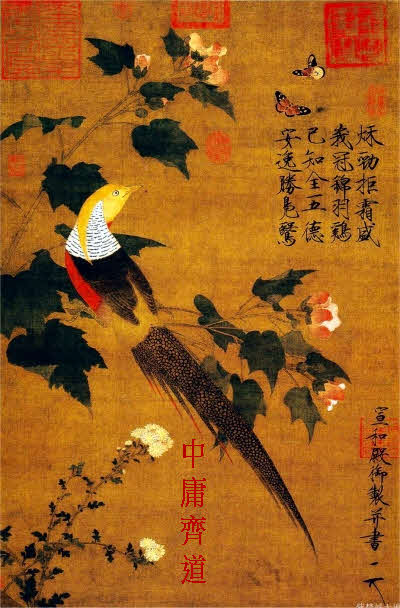中庸齊道 (Zhong Yong Chi Dao - Center Express Harmony Way) part 4

(PD) 中庸齊道 Zhong Yong Chi Dao - Center Express Harmony Way — Zhong Yong Chi Dao on Golden Pheasant
(Wording and photograph enhancements by Larry Neal Gowdy.)
Copyright ©2018 August 16, 2018
中庸齊道 Zhong Yong Chi Dao - Center Express Harmony Way — part 4
The first sentences had established a harmonious sequence of Zhong Yong's logic:
Zhong Yong Chi Dao:
Source nascents, it call nascent-ness.
Ratio nascent-ness, it call way.
Create way, it call standard.
The following sentence is worthy of a translation that retains the chi dao harmony.
道也者不可須臾離也可離非道也
道 = dao = 'way', 也 = ye = 'also, too', and 者 = zhe = 'person, -ist, -er'.
'Way also way-ist'. Choosing English words that most comfortably convey the message: 'Way also daoist'. The concept appears to be simple enough, that the 'create way' is the standard of individuals' who live the 'create way standard'.
不 = bu = do-not, no, non-, not.
可 = ke = (particle used for emphasis), able to, be able to, can, certain(ly), may, to suit.
須 = xu = must, have to, should, necessary: noun= beard, palpus, feeler.
臾 = yu = little while, a moment.
離 = li = from, off, without: adverb = away: verb= to depart, part, to go away, to leave.
也 = ye = also, too.
'Not able must a-moment leave also
可 = ke = (particle used for emphasis), able to, be able to, can, certain(ly), may, to suit.
離 = li = from, off, without: adverb = away: verb= to depart, part, to go away, to leave.
非 = fei = non-, not-, un-.
道 = dao = a measure word, direction, method, method, path, principle, reason, road, skill, Tao (of Taoism), to say, to speak, to talk, truth, way.
也 = ye = also, too.
'Able leave, not way also'
All languages place words within different sequences, and it is normal for Asian languages to place the words at the ends of sentences that in English would have been placed near the beginning of sentences. The word 'also' is frequently used at the end of Zhong Yong sentences, but for English-speaking individuals it might be easier to either place 'also' at the beginning of the sentence or else simply omit the word when initially helpful.
Too, English punctuation is questionable and subjective when inserted into Chinese texts, and there is no firm reason to accept the common translations' punctuation.
'Way also daoist'
The first three words, 'Way also daoist', are in harmony with the first three sentences, while 'Way also daoist' connects with and helps to give additional depth to the following words also. It is plausible that the three words could be placed within a sentence of their own, although, however, it is a common interpretation that the three words are a portion of the sequence that includes the sentence's following words.
'Not able must a-moment leave also. Able leave, not way also.
'Not able must a-moment leave also' appears to be saying 'not able to leave the Source's way so much as for a moment, even if there were a reason that you must leave'. The concept is correct; no one can leave Creation for so much as an instant, even if there was a dire need to leave.
'Able leave, not way also' appears to be saying 'also, if you can leave your dao, then your dao was not Source's way'. Any teaching, instruction, or system of belief that can be changed, was not a correct way. The only possible correct way is Source's (Nature's) way.
'Way also daoist not able must a-moment leave also able leave not way also'
Zhong Yong Chi Dao:
Source nascents, it call nascent-ness.
Ratio nascent-ness, it call way.
Create way, it call standard.
Way also daoist.
Not able must a-moment leave also.
Leave, not way also.
Regardless of punctuation and use of 'also', all of the sentences and concepts agree with and help explain the others within a harmonious concept, as well as being of harmony with the remainder of the book: chi dao.